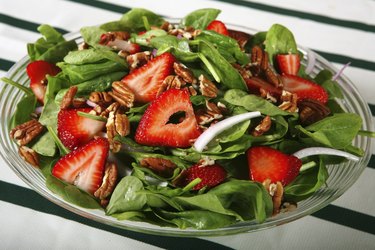
Your stool can change color for a variety of reasons: from certain medications to medical conditions. Food can also change the color of your stool. While the color of your stool can vary, certain colors can indicate a potentially serious problem. Consult your physician if the color of your stool worries you.
Shades of Brown
Video of the Day
Generally all shades of brown are considered normal. The shade of brown may vary slightly for a variety of reasons: from how much fat you consumed, to how much grain was in your diet. This is considered normal and there's no need for alarm. Fat turns to bile during the digestion process and can lighten the color of your stool. The concentration of the bile will determine how light your stool becomes, according to MedlinePlus. If it becomes so light that it's almost white in appearance, this can indicate that you have a clogged bile duct. Clay-colored or white stool can indicate there is no bile in your stool; this can mean your gallbladder, liver or pancreas isn't functioning properly.
Video of the Day
Shades of Green
Vegetables such as spinach or lettuce can turn your stool green. Foods and drinks such as sports drinks or popsicles with green-colored dyes can also make your stool turn green, as well as iron supplements. Green stool may be an indication that food is traveling too quickly through your large intestine, much like when you develop diarrhea; this means your bile has not had a chance to break down completely.
Black
Black dyes in foods such as licorice or foods colored with black food coloring can cause your stool to turn black. Other than food coloring or dyes, there is no other food-related reason why your stool would turn black. Black stool can indicate a serious condition, such as blood in your stool.
Red
You may have red or pink-colored stool from eating certain foods such as beets, rhubarb, radishes and turnips, as they are all red or pink in color. Red food dyes and food coloring can also cause your stool to become a shade of red or pink. A red or pink stool may also be an indication of the presence of blood. If you suspect blood in your stool, consult with your physician right away. This could indicate a serious medical condition that requires prompt treatment. At-home stool kits are available to test for the presence of blood; however, you should never rely on an at-home test response in case the test is defective, becomes contaminated or was not correctly performed.
Is this an emergency? If you are experiencing serious medical symptoms, please see the National Library of Medicine’s list of signs you need emergency medical attention or call 911.